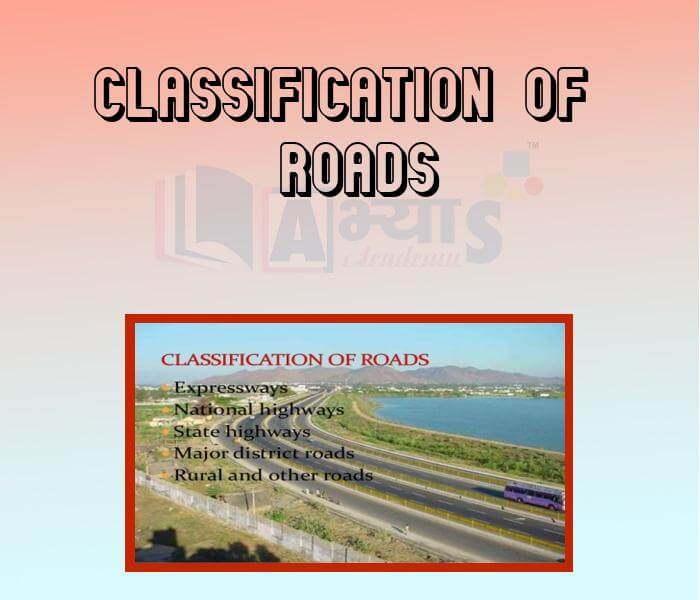Classification of Roads













Classification of Roads
Classification of Roads on the Basis of Capacity: In India, roads are classified in six classes according to their capacity as given below:-
(i) Golden Quadrilateral Super Highways: This is a major road development project linking India's four largest metropolies, i.e. Delhi-Kolkata- Chennai-Mumbai by six-lane Super Highways. The North-South Corridor linking Srinagar (Jammu and Kashmir) and Kanyakumari (Tamil Nadu) and East-West Corridor connecting Silchar (Assam) and Porbandar (Gujarat) are also parts of this project.
These Super Highways reduce the time and distance between the mega cities of India. The National Highways Authority of India (NHAI) is the staple agency for implementing these highway projects.
(ii) National Highways: They link extreme parts of the country, National Highways are the primary road systems, and are constructed and maintained by the Central Public Works Department (CPWD) under NHAI's supervision. Some well-known National Highways are given below
| National Highways | Cities Links | Remarks |
| NH-1 | Delhi-Amritsar-Attari (Pakistan border) | The combined length of NH-1 and NH-2 is also known as Sher Shah Suri Marg. |
| NH-2 | Delhi-Kolkata | |
| NH-3 | Agra-Mumbai via Indore | |
| NH-7 | Varanasi-(via Jabalpur, Nagpur, Hydrabad, Bangaluru and Madurai) Kanyakumari | The longest National Highway (2,369 km) |
| NH-8 | Delhi-Mumbai via Ahmedabad | Part of the Golden Quadrilateral |
| NH-15 | Pathankot to Samkhiyali | Covers most of Rajasthan |
(iii) State Highways: These are roads linking a state capital with its district headquarters. They are constructed and maintained by the State Public Works Department (SPWD) in States and Union Territories.
(iv) District Roads: These roads connect the district headquarters with other places of the district. These roads are maintained by the Zila Parishad of the district.
(v) Other Roads: Rural roads, which link rural areas and villages with towns, are classified under this category. Under the Pradhan Mantri Grameen Sadak Yojana (PMGSY), special provisions are made to link every village in the country to a major town by an all season motorable road.
(vi) Border Roads: The Border Roads Organisation (BRO) contructs and maintains roads in the border areas of the country. It was started in 1960 for the development of roads of strategic importance in the Northern and North-Eastern border areas of the country. Border roads have improved accessibility in areas of difficult terrain and have helped in the economic development of these areas.
Classification of Roads on the Basis of Material Used: Classification of roads is also done in the basis of material used for their construction. On this basis, roads are of two types
(i) Metalled roads- may be made of cement, concrete or even birumen of coal. Therefore, these are all weather roads.
(ii) Unmetalled or unpaved roads -can be of different types. They can be clay roads, which can only serve dry-season light traffic. They can also be heavy-duty crushed rock industrial roads which can serve heavy traffic. Unmetalled roads become difficult to use in the rainy season, as they do not use waterproof materials for construction.
Unsurfaced roads are also important because : | |||
| Right Option : D | |||
| View Explanation | |||
The longest National Highway No. 7 connects ___________ . | |||
| Right Option : B | |||
| View Explanation | |||
Which of the following roads have maximum strength? | |||
| Right Option : A | |||
| View Explanation | |||
Students / Parents Reviews [10]
Abhyas is a complete education Institute. Here extreme care is taken by teacher with the help of regular exam. Extra classes also conducted by the institute, if the student is weak.

Om Umang
10thMy experience with Abhyas is very good. I have learnt many things here like vedic maths and reasoning also. Teachers here first take our doubts and then there are assignments to verify our weak points.

Shivam Rana
7thOne of the best institutes to develope a child interest in studies.Provides SST and English knowledge also unlike other institutes. Teachers are co operative and friendly online tests andPPT develope practical knowledge also.

Aman Kumar Shrivastava
10thIt was a good experience with Abhyas Academy. I even faced problems in starting but slowly and steadily overcomed. Especially reasoning classes helped me a lot.

Cheshta
10thIt was good as the experience because as we had come here we had been improved in a such envirnment created here.Extra is taught which is beneficial for future.

Eshan Arora
8thIt has a great methodology. Students here can get analysis to their test quickly.We can learn easily through PPTs and the testing methods are good. We know that where we have to practice

Barkha Arora
10thBeing a parent, I saw my daughter improvement in her studies by seeing a good result in all day to day compititive exam TMO, NSO, IEO etc and as well as studies. I have got a fruitful result from my daughter.

Prisha Gupta
8thA marvelous experience with Abhyas. I am glad to share that my ward has achieved more than enough at the Ambala ABHYAS centre. Years have passed on and more and more he has gained. May the centre flourish and develop day by day by the grace of God.

Archit Segal
7thAbhyas Methodology is very good. It is based on according to student and each child manages accordingly to its properly. Methodology has improved the abilities of students to shine them in future.

Manish Kumar
10thAbout Abhyas metholodology the teachers are very nice and hardworking toward students.The Centre Head Mrs Anu Sethi is also a brilliant teacher.Abhyas has taught me how to overcome problems and has always taken my doubts and suppoeted me.
